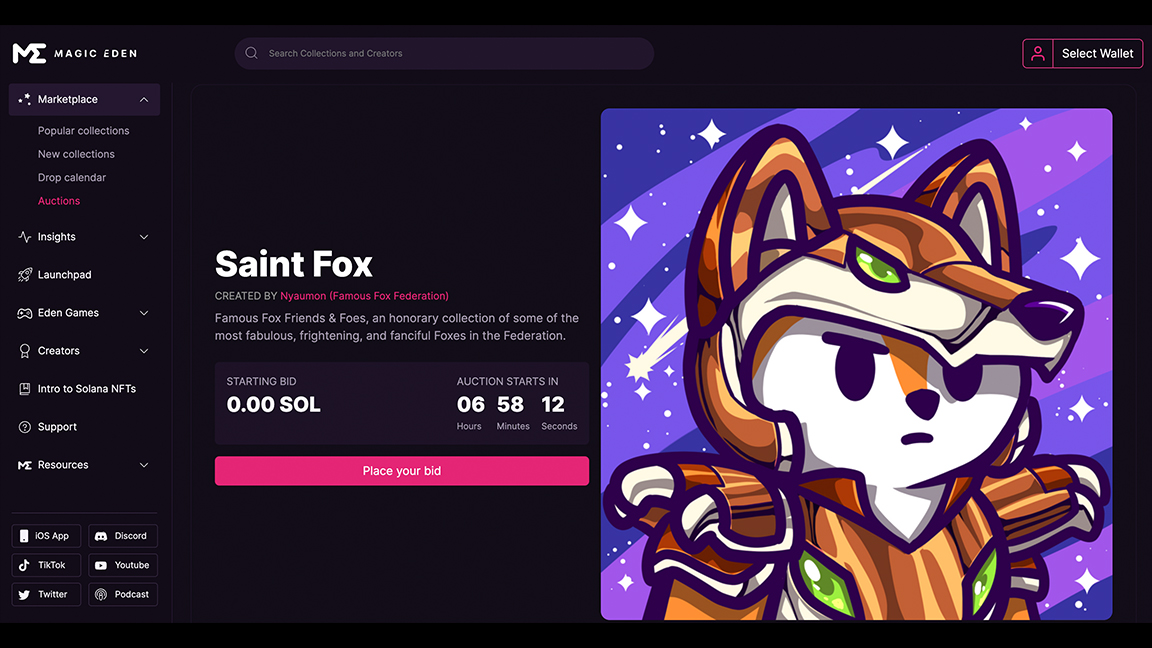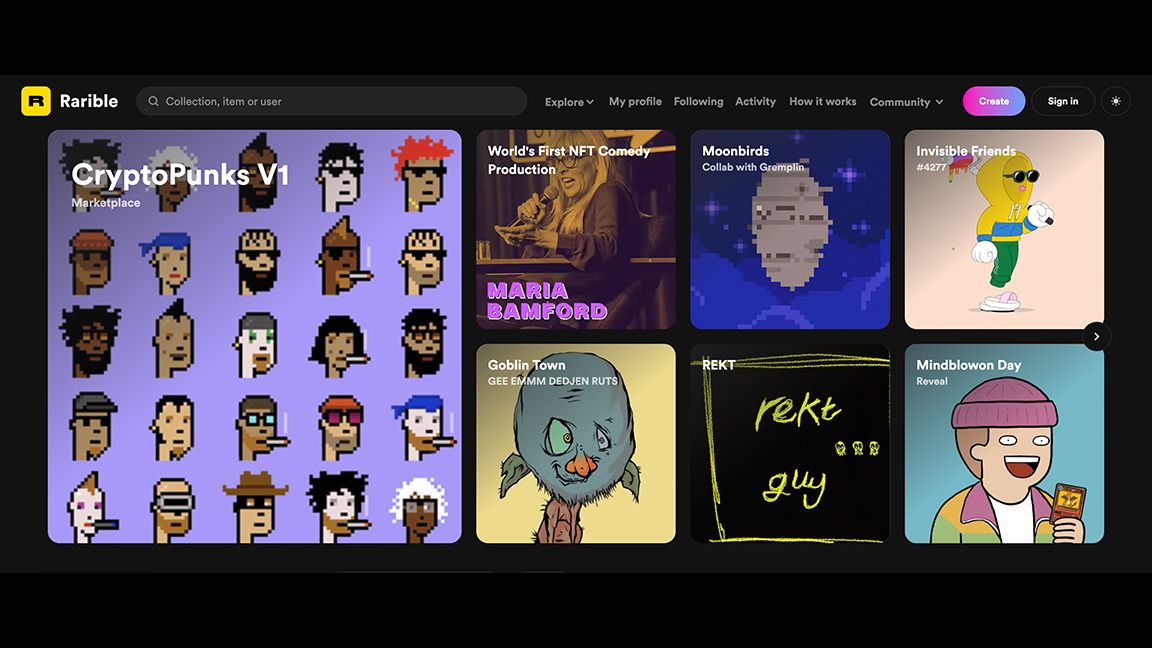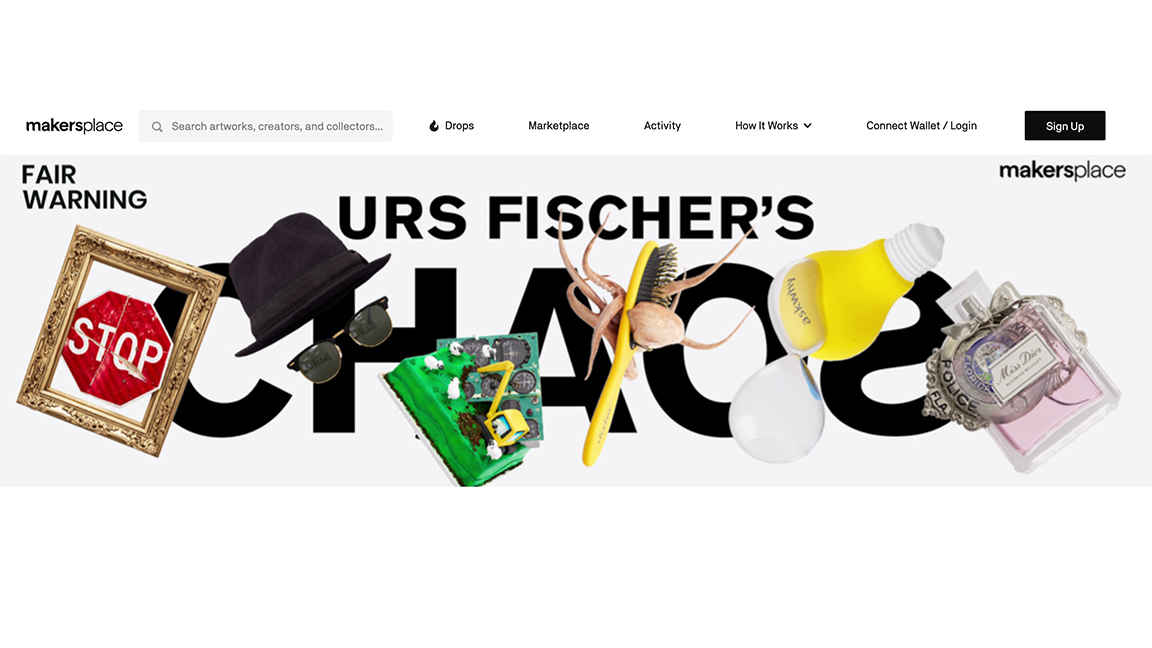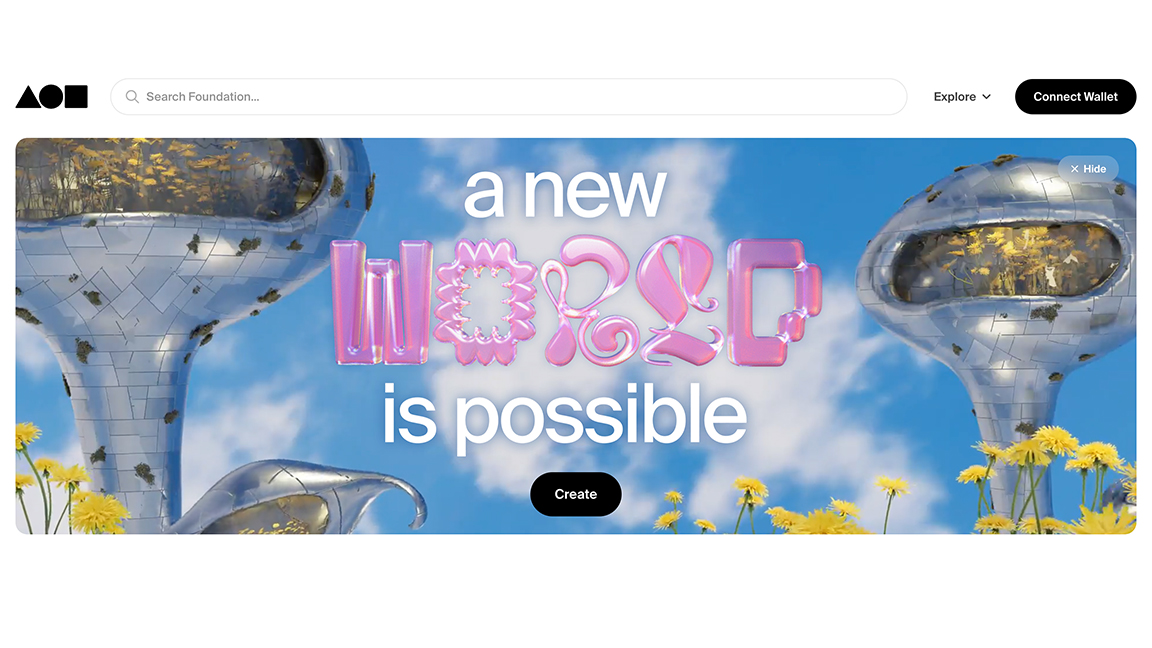
The best NFT marketplaces can be the difference between you selling a new piece of art or finding a create new project to collect. NFT marketplaces are also not simply stores to buy and sell digital art but a doorway into a community of passionate artists and collectors.
To find the best NFT marketplace for you means considering the fees you'll be charged, the kind of art that is sold – does it match your style? – and even the blockchain and cryptocurrency that will be used. There are many to pick from, and we have a guide to NFT crypto that can help. Most NFT marketplaces use Ethereum but some are opting for the cheaper gas fees (which you have to pay to create your NFT) and better carbon footprint offered by newer blockchains.
Below we've gathered up the best and most interesting NFT marketplaces where you can sell and buy digital art. Whether you're buying, selling, or just NFT-curious, one of these marketplaces should suit your needs. After even if you're not planning to use an NFT marketplace at the moment, anyone in the creative industry right now should probably know what they are and how they work.
If you're still wondering what an NFT this, then we'd recommend doing some catching up first by reading our what are NFTs? guide. If you're up to speed and think NFTs offer a possible outlet for your own creative work, then you take a look at my tutorial on how to create an NFT for free or read my feature NFT meanings, slang and terms: all you need to know, which details all of the terms people use.
If you have an NFT or collection and what to show it off, then read my feature 'Why Tokenframe is one of the best NFT frames for digital art' to discover one of the best NFT displays.
If you're ready, read on for our pick of best NFT marketplaces. For a more detailed explanation of some of the terms used in this guide, you can find frequently asked questions at the end.
The best NFT marketplaces
01. OpenSea
Specifications
Reasons to buy
Reasons to avoid
OpenSea is one of the oldest and most used NFT marketplaces. It's also one of the broadest, hosting every kind of NFT, from art to music, photography and sports collectables. Think of OpenSea as the Amazon of NFT marketplaces. It really does stock everything. This is supported by its support of more than 150 cryptocurrency payment tokens. OpenSea is easy-to-use and you can set up an account for free and start minting, selling and browsing in minutes.
Daily design news, reviews, how-tos and more, as picked by the editors.
What's more, OpenSea now boasts that it's a gas-free NFT marketplace through cross-blockchain support. The marketplace now supports the Polygon cryptocurrency, which means you won't have to pay fees when making trades. That means artists can "fully earn their way into crypto for the first time," OpenSea reckons.
Visit the OpenSea marketplace now

02. Magic Eden
Specifications
Reasons to buy
Reasons to avoid
Magic Eden is fast-becoming one of my favourite new NFT marketplaces. Since the NFT Crash there has been a slow reduction in the use of Ethereum for trading and minting NFTs – it's still massive, but is slowing down in use due to high gas fees.
In its place is Solana, a newer blockchain that is cheaper and more environmentally friendly. It saw a huge spike at the end of May when, according to CryptoSlam, Solana NFT sales were up 436% over that 24-hour span compared to the previous period.
If you want to get into Solana NFTs you'll need a specific wallet – we'd suggest Phantom – and there's no better NFT marketplace that Magic Eden, a dedicated Solana platform. You can find established NFT collections such as Trippin’ Ape Tribe as well as many new collections. The only downside is you need to apply for listing if you wish to launch a collection or an NFT.
Visit the Magic Eden NFT marketplace now
03. Nifty Gateway
Specifications
Reasons to buy
Reasons to avoid
Nifty Gateway is perhaps the NFT marketplace that sees the most eye-catching big-money NFT sales. It's where two of the most expensive NFTs yet were sold: Beeple's CROSSROAD and Pak's The Merge, which sold for US$91.8 million in December 2021 (that's still the world's most expensive NFT at the time of writing).
The platform gets a lot of love on Twitter and draws in celebrity NFTs. But don't let that put you off. Nifty Gateway has a couple of standout points. First, it makes use of 'open editions', an unlimited number of editions are created for a limited period of time, and are sold at a base price. Once timed out, no more NFTs are issued, ever. This causes scarcity and a strong market in secondary sales. Second, Nifty enables collectors to buy NFTs using Fiat (government-issued currency), which means buyers can make purchases using credit cards and not cryptocurrency. That makes it more friendly for new buyers who aren't used to crypto wallets.
Visit the Nifty Gateway marketplace now
04. Rarible
Specifications
Reasons to buy
Reasons to avoid
Rarible is an NFT marketplace designed to sell both single pieces of art and collections. It attracts sports, gaming, and media brands as well as artists releasing collections of works. Rarible is community-owned and promotes decentralisation. It uses its own token, RARI, and the platform's users take part in moderation and get to vote on any platform upgrades. Rarible has partnered with some big brands to secure artists work and create unique NFTs, including Adobe.
As well as Ethereum, Rarible uses Flow and Tezos blockchains. When you mint your NFT, you choose which token you'll use, and you can share search options with OpenSea. Which blockchain to choose is an interesting question. Ethereum is the most used for NFT minting, but its carbon footprint and gas fees are high. Tezos gas fees are low (around $0.50) but it's geared towards artists releasing collections. Flow uses what's called 'lazy minting', which means creators pay near-zero fees plus it's a 'proof-of-stake' blockchain, offering a far lower carbon footprint than Ethereum.
Visit the Rarible NFT marketplace now

05. Coinbase NFT
Specifications
Reasons to buy
Reasons to avoid
The Coinbase NFT marketplace is one of the newest around, having only launched fully in April. Coinbase itself has been at the heart of the crypto boom for some time, it's trading app and platform is one of the easiest to use and most secure. That said, the site has had problems, launching its NFT marketplace just as the NFT crash happened was bad luck.
Presently Coinbase NFT all of the pieces to become big hit; it can be easily connected to the Coinbase trading app and the Coinbase crypto wallet, it's incredibly easy to use and has one of the most robust user experiences around, there are exclusive NFT projects launching on the marketplace – Bored Ape Yacht Club film trilogy – and for a limited time new users get 0% transaction fees.
Visit the Coinbase NFT marketplace now

06. Binance NFT
Specifications
Reasons to buy
Reasons to avoid
Binance is one of the largest crypto exchanges, and its Binance NFT is becoming one of the largest NFT marketplaces around. It's also supported by its own blockchain. For these reasons Binance NFT is seen as one of the most future-proof NFT marketplaces.
Its size and scale mean this marketplace can offer exclusive partnerships and events others may envy. If you have Binance tokens (BNB) accessing the marketplace is even easier, and you can you can use ETH, BNB, and BUSD to bid. You can deposit ETH or BSC NFTs if you're looking to sell.
Visit the Binance NFT marketplace now
07. SuperRare
Specifications
Reasons to buy
Reasons to avoid
SuperRare brings more of a gallery attitude to the NFT space. It's an art-first NFT marketplace that puts credibility and artistic intent above meme-friendly art. You won't find SuperRare filled with celebrity NFTs. It reportedly only accepts 1% of the artists who apply, which sounds elitist, but it means that if you're accepted you know you're in a catalogue of highly curated and interesting artworks.
The approach makes SuperRare feel like a high-end gallery, and that's further enhanced by a rule enabling its artists to mint one of their originals – no Editions here. This means the pieces are more scarce and so, as the name suggests, rare. SuperRare is one of the best NFT marketplaces for serious art and artists.
Visit the SuperRare NFT marketplace now
08. Async Art
Specifications
Reasons to buy
Reasons to avoid
Async Art is an NFT marketplace known for 'programmable art'. Each work of art is made up of a Master and Layers; Masters are the entire NFT while Layers are separate elements that make up the art, and can be modified. Everything is 'Tokenized' meaning that different artists can own different layers and contribute to transforming the artwork.
Programmable art is at the avant-garde of digital art. It enables multiple creators to alter an artwork over time, and it's a kind of NFT art that can't be shared on more traditional gallery platforms such as SuperRare. Async Art has also launched Blueprints, enabling artists to create generative projects in the vein of Bored Apes.
Visit the Async Art marketplace now
09. MakersPlace
Specifications
Reasons to buy
Reasons to avoid
MakersPlace is another interesting NFT marketplace for more serious art. Here you can find established artists, galleries and institutions offering NFTs of their work, including the likes of Damien Hirst, Christie’s auction house and comic legend Robert Liefeld.
Artists on MakersPlace digitally sign their art. which is recorded on the blockchain. Only a limited number of authentic editions are minted creating scarcity, and buyers get full ownership of the artwork – even if the art is downloaded and copied, it won't be authentic or carry the artist's digital signature.
Visit the MakersPlace NFT marketplace now
10. KnownOrigin
Specifications
Reasons to buy
Reasons to avoid
KnownOrigin is one of the oldest NFT marketplaces. It focuses on offering rare and collectible artworks in timed-released events, known as drops, which enable artists to control the number of copies released. This can create scarcity and ramp up prices. Artists need to apply to join and must be vetted, which only adds the exclusivity.
This marketplace uses Ethereum to mint, so you may want to consider the fees and carbon footprint when bidding. KnownOrigin does also support collaborations on NFTs and makes a big effort to support community messaging and offer advice around drops and sales, including making secondary sales clear in a separate marketplace. Example drop on KnownOrigin include Seth Tillett's Jean Michel Basquiat photo collection.
Visit the KnownOrigin NFT marketplace now
11. Mintable
Specifications
Reasons to buy
Reasons to avoid
If OpenSean is Amazon of the NFT platforms then Mintable is Etsy. This newcomer to the NFT marketplace is backed by billionaire Mark Cuban and aims to offer broad content and be easy to use.
In practice this means you can create an NFT from nearly any digital file – image, gif, video, audio file, text document and more – and add it to your store on the platform. It's very easy and requires little knowledge of NFTs, crypto wallets or blockchains. While Mintable supports Ethereum as standard, you can also mint using Immutable X for free gas fees. Making life even easier, Mintable University is a free resource on the marketplace featuring handy video courses to get better at NFTs.
Visit the Mintable NFT marketplace now
12. Foundation
Specifications
Reasons to buy
Reasons to avoid
Foundation was run like an artist's club few get an invite to; it began as a community-curated platform run by a select number of artists. But now it's opening its doors to everyone. It's only been running for a year, but its creators have already earned a combined $163,263.94. To join Foundation you need an invite from a current artist, and each artist only has one invite to use.
Selling an NFT on Foundation earns the artist 85% of the value, and secondary sales earn 10%. This is lower than some other NFT marketplaces, but you'll find NFTs on Foundation are priced higher on average and hold their value. Creators tend to be more authentic and genuinely artistic than you may find on some other marketplaces.
Visit the Foundation NFT marketplace now

13. BakerySwap
Specifications
Reasons to buy
Reasons to avoid
BakerySwap is a small NFT market aimed at crypto fans. You'll likely find better art on other marketplaces, such as Foundation and SuperRare, but this space is designed to encourage and reward its community with gamification rewards.
This is an automated market maker (AMM) and decentralized exchange (DEX) on Binance Smart Chain (BSC). It uses a native BakerySwap token (BAKE). The food analogy of the marketplace extends to earning bonus BAKE tokens through 'combo meals'.
The BakerySwap marketplace hosts regular art and meme competitions, and you can buy NFT games using earned BAKE tokens. This marketplace supports a broader metaverse of content. Along with all of this, BakerySwap is easy-to-use for newcomers to NFT buying and selling.
Visit the BakerySwap marketplace now
14. Zora
Specifications
Reasons to buy
Reasons to avoid
Zora began life as an artist invite-only platform similar to Foundation but has since pivoted to an open marketplace that anyone can use. It's devoted to giving artists and creators more ownership and power over their art. It's also easy to use and enables perpetual bids, so anyone can bid in any currency.
This marketplace has evolved into a good space for music NFTs and a platform that bridges the real and digital worlds. Zora auctioned off digital and physical copies of RAC's Boy album on cassette. In this vein, Zora is becoming the marketplace to find physical items sold to super-fans, such as Nike designer Jeff Staple who sells limited edition trainers on the platform.
Visit the Zora NFT marketplace now
The best NFT marketplaces: frequently asked questions
There's a lot of jargon involved in the world of NFT marketplaces, and some controversy around NFTs themselves. Many NFT marketplaces are trying to make their platforms easier to use, and some even now take debit and credit cards as well as crypto wallets, so creating, selling and buying NFTs is becoming easier. Below are the answers to some common questions many newcomers to the NFT scene still have.
What are gas fees?
This is the charge you need to pay on the Ethereum blockchain to perform a function, which includes the case of creating (minting) an NFT. Gas fees are measured in gwei, and they can go up and down depending on how heavy the use of the blockchain is. On average you'll be charged 0.0042 ETH per transaction. You can find lower fees early in the morning, between 1am and 3 am (UTC) or late at night, between 9pm and 11 pm (UTC).
Can I avoid gas fees?
Yes, some NFT marketplaces are offering gas-free minting. These including OpenSea and Rarible. This approach essentially places the gas fee on the buyer not the creator, so it will show in the sale (a little like VAT, or the fuel tax added by some airlines). There are some blockchains that have no gas fees or at least lower fees. These include Polygon on Opensea, or ImmutableX on Mintable. Before minting or buying an NFT, look into the fees and at which blockchain and token are being used.
What is minting?
Like with physical currency, "minting" is the term used for the process of creating a currency and NFTs on a blockchain. With NFTs it's usually on Ethereum. The process of minting records data in a public ledger that is unchangeable and tamper-proof, and which can follow and track the NFT as future sales are made. Minting usually has a cost – the gas fee that we mentioned above. But as we said, some marketplaces are becoming creative about how, when and to whom the fees are charged.
What's a blockchain?
Investopedia describes a blockchain as: "a distributed database that is shared among the nodes of a computer network." The strength of blockchain tech is that it guarantees security and trust without the need for a third-party, speeding up data transactions. The data entered is irreversible, ensuring it's permanent. For NFTs, it means the artist can trace their NFT and ensure a percentage on future sales.
Do I need a crypto wallet?
In most cases, yes. In most cases, you will need to pay in cryptocurrency to mint an NFT, or to buy an NFT. As a result, most NFT marketplaces require you to create a crypto wallet to mint and trade NFTs. A common one is MetaMask, though Coinbase is another secure wallet. Some newer NFT marketplaces, such as Nifty Gateway, have started allowing the use of Fiat currency payments (US dollars, etc) via credit and debit cards, making access to NFTs easier.
Can anything be an NFT?
Yes. Any kind of digital file can be stored as an NFT. Most marketplaces are set up for digital artwork, but more are now supporting video, game assets, and music. Physical items are also now digitised as NFTs, for example physical limited edition Nike trainers. Expect NFTs to exist on and between the digital and physical spaces in the future.
Are NFTs controversial?
Yes. You can't escape the fact Ethereum minting has a high carbon footprint, but perhaps not as high as some believe. Yet everyone accepts there is a problem. Ethererum 2.0 should solve this issue, and is due this year.
Are there any energy-efficient blockchains?
Yes, and NFT marketplaces are now offering alternatives to energy-hungry Ethererum with better carbon footprints. These include Flow, Tezos, and Polygon. New blockchain Solana boasts of being carbon-neutral. Check on your NFT marketplace which is being used and opt for one that suits your conscience.
Disclaimer: The opinions expressed in the article are for general informational purposes only and are not intended to provide specific financial or investment advice or recommendations for any individual for any investment product. The article is only intended to provide general information and opinions about NFT marketplaces. The views reflected in this article are subject to change at any time without notice.
Read more:
- The best NFT displays
- NFT gaming: 10 things you need to know
- Take a look at this weird Crypto House

Ian Dean is Editor, Digital Arts & 3D at Creative Bloq, and the former editor of many leading magazines. These titles included ImagineFX, 3D World and video game titles Play and Official PlayStation Magazine. Ian launched Xbox magazine X360 and edited PlayStation World. For Creative Bloq, Ian combines his experiences to bring the latest news on digital art, VFX and video games and tech, and in his spare time he doodles in Procreate, ArtRage, and Rebelle while finding time to play Xbox and PS5.










